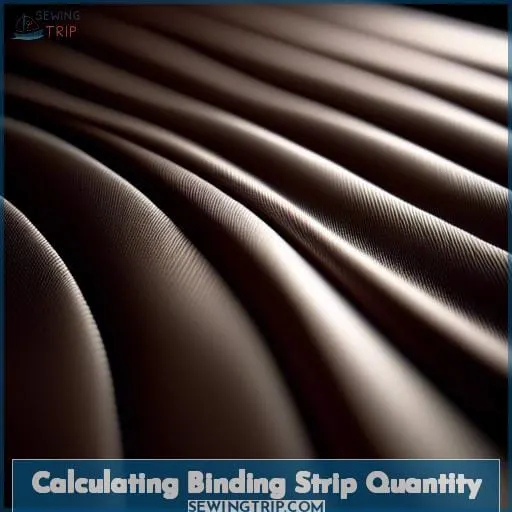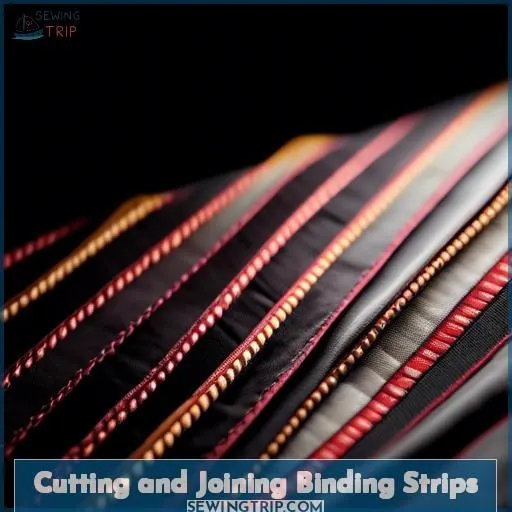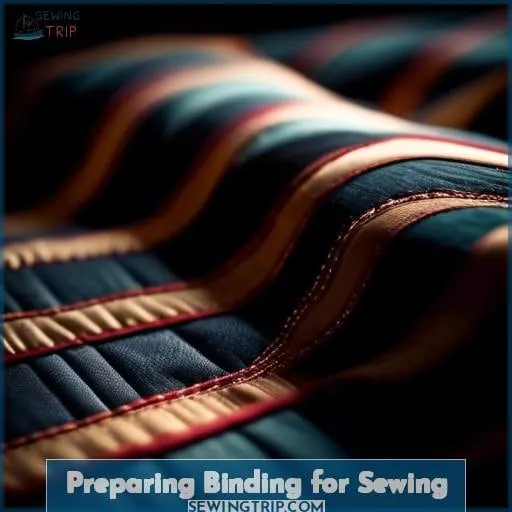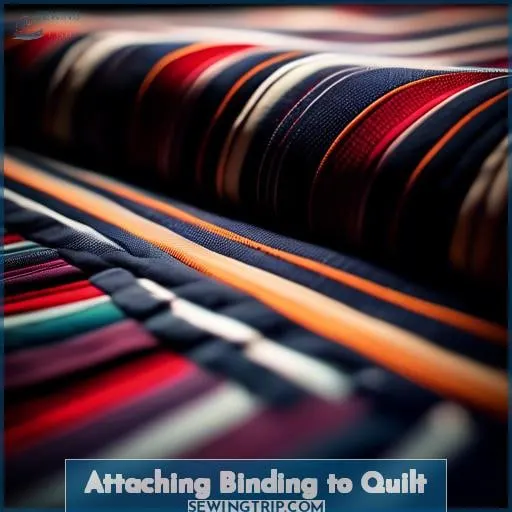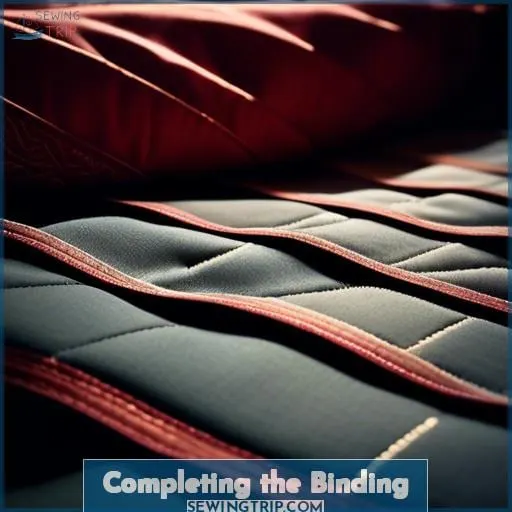This site is supported by our readers. We may earn a commission, at no cost to you, if you purchase through links.
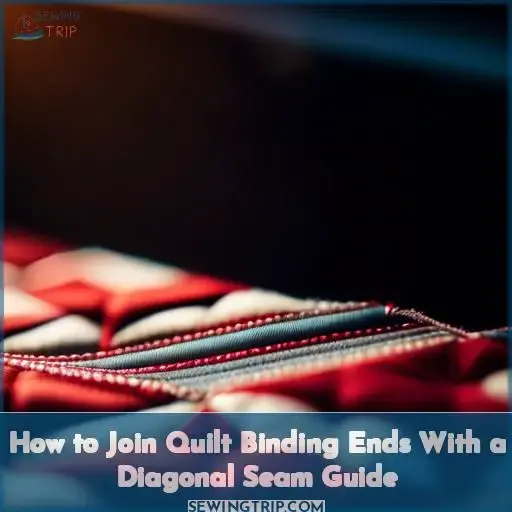
This guide will walk you through the process, ensuring you’re equipped to tackle this crucial step with confidence. You’ll learn how to calculate, cut, and join binding strips, attach them with precision, and complete your quilt with a polished look.
Let’s dive into how to join quilt binding ends with a diagonal seam.
Table Of Contents
Key Takeaways
- To calculate the amount of binding needed, add the length and width of the quilt, multiply by 2, add 10 inches for seam allowances and ease, then divide by 40 (the typical width of fabric in inches) and round up to the nearest whole number.
- When cutting and joining binding strips, place them right sides together at a 90-degree angle, draw a diagonal line where they overlap, sew along this line, then trim the seam allowance to 1/4 inch and press the seam open to reduce bulk.
- Before attaching the binding to the quilt, ensure that the binding strips are pressed in half lengthwise, with no trimming of the ends necessary for most cotton fabrics, to prepare for a smooth sewing process.
- To attach the binding to the quilt, start with a long tail, miter the corners for a neat finish, and leave a gap between the start and end of the binding. Join the ends with a diagonal seam to reduce bulk and ensure a flat, smooth finish.
Calculating Binding Strip Quantity
Ready to figure out how much binding you’ll need for that cozy quilt of yours? Let’s dive in.
First, grab your quilt’s dimensions—length and width are the key players here. Add those numbers together, double the total for a full wrap-around, and toss in an extra 10 inches for good measure.
Now, divide by 40, the typical width of fabric, and round up to the nearest whole number.
Cutting and Joining Binding Strips
You’ll need to align your strips diagonally before sewing. This step ensures your seams are pressed flat for a smooth finish.
Aligning Strips Diagonally
When joining your quilt binding strips, precision is your best friend. Align them diagonally to ensure joining accuracy and to reduce bulk.
Draw your diagonal lines with care; this step is the secret sauce for a neat finish.
Sewing and Pressing Seams
After aligning your strips diagonally, it’s time to dive into sewing and pressing those seams.
- Sew along the line you’ve drawn, connecting the strips with a diagonal seam. This stitch type ensures your fabric choices lay flat when you join quilt binding ends.
- Trim the seam allowance to about 1/4 inch to reduce bulk.
- Use your pressing tools to iron seams open, setting the stage to sew binding to the back of your project seamlessly.
Preparing Binding for Sewing
After mastering the art of cutting and joining your binding strips, it’s time to prep them for sewing, which is like setting the stage for a grand performance. Your binding strip is the star, and you’re the director. Here’s where folding techniques and ironing methods take center stage.
Different fabric types and binding materials require specific temperature settings, so keep your iron handy and set it according to your fabric’s needs.
| Folding Techniques | Ironing Methods |
|---|---|
| Crisp center fold | Low heat for delicate fabrics |
| No trimming of ends | Medium heat for most cottons |
| Aligning for diagonal seam | High heat for thick or stubborn materials |
| Ensuring smooth edges | Steady pressure, no sliding |
Attaching Binding to Quilt
When attaching the binding to your quilt, it’s crucial to miter the corners for a neat finish.
Leaving long tails at both ends will prepare you for the final joining step.
Mitering Corners
When you’re rounding the bend on your quilt, corner accuracy is your best friend.
Think of mitered corners as the perfect miter meeting at a bustling crossroads. With your angled cut and binding techniques, you’re the maestro conducting a symphony of fabric.
Use diagonal seam quilt binding for bulk reduction and chain piecing for efficiency.
Joining quilt binding strips becomes a dance, and your quilt binding techniques ensure every corner is a showstopper.
Leaving Tails for Joining
When attaching quilt binding, it’s like setting the stage for the grand finale. Here’s how to ensure a smooth performance:
- Start with a 12-inch beginning tail; it’s your safety net.
- Sew around, leaving a 12-inch gap; that’s your stage.
- Keep an excess of binding; it’s the encore.
Completing the Binding
You’re almost finished with your quilt, and it’s time to join the binding ends seamlessly.
Let’s tackle the diagonal seam method, sew up the binding gap, and apply the final ironing touches for a polished look.
Joining Ends With Diagonal Seam
Joining quilt binding ends with a diagonal seam is like aligning stars in the quilting universe. It’s all about precision and reducing seam bulk. Use notching and pleating to ensure your binding edges meet perfectly.
| Step | Action | Benefit |
|---|---|---|
| 1 | Align | Ensures diagonal seam placement accuracy |
| 2 | Sew | Reduces seam bulk for a smoother edge |
| 3 | Notch | Prepares edges for perfect alignment |
| 4 | Pleat | Eases the binding around the quilt’s corners |
| 5 | Iron | Sets the seam, securing your star-st� work |
Sewing the Binding Gap
Now, let’s sew that binding gap shut, shall we? Here’s how:
- Notch and pleat your fabric, making it as snug as a bug.
- Mark and pin with precision, like you’re plotting a treasure map.
- Stitch away and press that binding seam, sealing your quilt’s fate with finesse.
Finishing Touches With Ironing
Once you’ve joined your quilt binding ends with that savvy diagonal seam, it’s time to press for success.
Crank up your iron and glide it along the binding, ensuring a crisp crease and a smooth edge.
These finishing touches will give your quilt that neat, professional look.
Frequently Asked Questions (FAQs)
How do I choose binding fabric color?
Choosing your quilt’s binding fabric color is like picking the perfect frame for a painting.
Go bold with contrasting colors.
Match a minor color in the quilt.
Use a pattern for a playful twist.
Can I use bias binding on straight edges?
Yes, you can use bias binding on straight edges. About 90% of quilters swear by its flexibility and durability.
It wraps around edges like a dream, even on straight lines, giving your project a polished finish.
What thread weight is best for binding?
For binding, you’ll want a thread that’s tough yet discreet.
A 50 wt cotton thread, like Aurifil’s orange spool, hits the sweet spot, ensuring your binding holds tight without stealing the show.
How do I fix twisted binding strips?
Wrestling with twisted binding strips is like untangling the world’s most stubborn spaghetti.
Simply roll them into a figure-eight pattern to keep them orderly and twist-free as you sew.
It’s a game-changer!
Is machine binding as durable as hand-sewn?
Machine binding can be just as sturdy as hand-sewn, especially if you’re racing against the clock.
It’s all about the technique, not the tool.
So, go ahead, give your sewing machine a whirl!
Conclusion
You’re almost there! The final step to achieving a seamless quilt is mastering how to join quilt binding ends with a diagonal seam. This technique ensures a polished, professional finish, blending the ends together almost invisibly.
By carefully aligning, sewing, and pressing your binding strips as outlined, you’ve prepared the groundwork for this crucial moment. Now, with precision and care, complete your quilt. The satisfaction of a beautifully finished project awaits, a testament to your skill and dedication.

